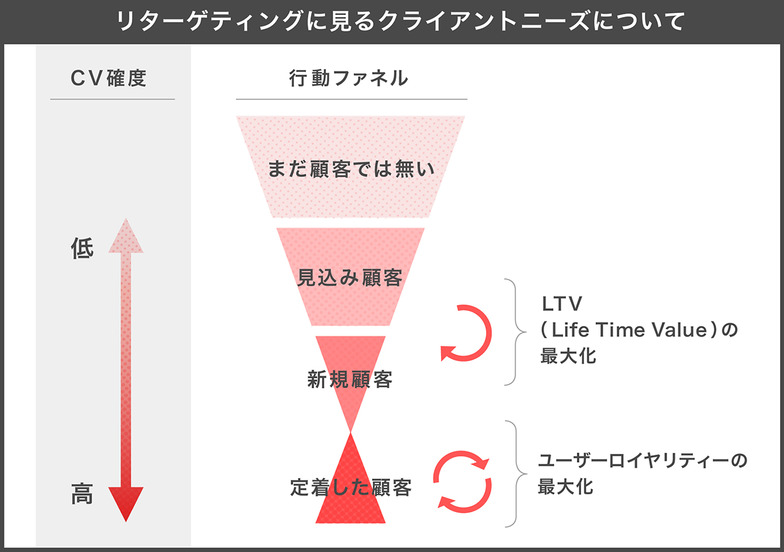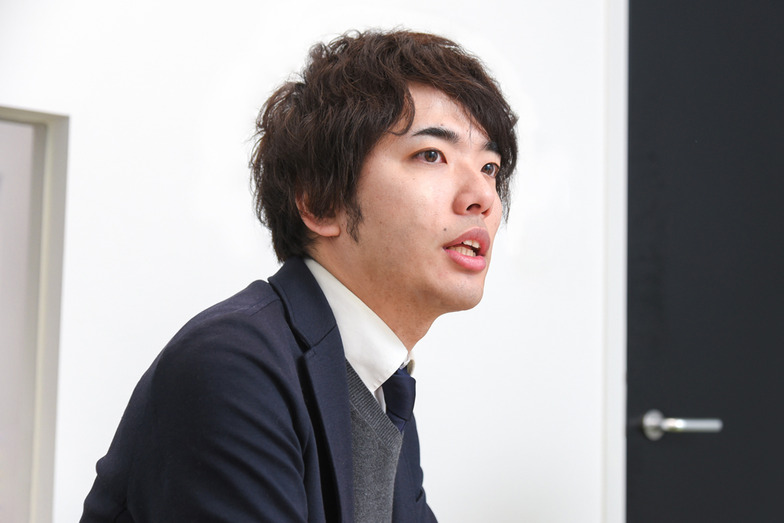In the first part, we discussed the trend toward automation in retargeting. Continuing on, we hear from Kensuke Iseda and Yu Saito about changes in the demand for retargeting and more.
*Note: Nexedge Dentsu Inc. changed its name to "Dentsu Digital Inc." on July 1, 2016.
Does the "Golden Path" Leading to Conversions Actually Exist!?
──What kind of needs do clients have regarding retargeting?
Isetada: When considering the funnel structure of prospects, new customers, and loyal customers, there are two approaches to retargeting: one to reach the prospect layer at the top of the funnel, and another to re-engage customers who have already converted.

Fundamentally, retargeting proves highly effective for direct businesses completed online or through mail order. Especially for harvesting campaigns targeting high-potential segments, the trend of using retargeting ads to encourage repeat purchases and maximize LTV (Life Time Value) will likely continue.
In direct business, there's a need to analyze individual customers closely—understanding who is taking what actions. Sometimes, this leads to detailed analysis driven by the expectation that there might be an optimal path, a "golden path" to conversion, and that guiding customers along this path via retargeting could yield better results.
However, the reality is that finding this golden path isn't so simple. The more you focus on individual customers, the harder it becomes to see overall trends. Finding the right balance in perspective is crucial; it involves verifying how deeply to delve and how to set the granularity level. Retargeting at the final push is effective, but the path to draw them there, the winning pattern, remains challenging.
Clients often demand granular analysis, so we must communicate that impact diminishes at smaller scales. We're also expected to propose solutions by considering "what's truly necessary for business growth."


Saito: On the other hand, for the challenge of pinpointing the right message for first-time buyers versus repeat buyers, we design retargeting with hypotheses. Those who've made one or two purchases have the potential to become loyal customers, so the key is how to capture that segment.
To do this, we analyze products for each client. We select the products featured in the ad creative based on the buyer's behavior: whether they buy the same product as their first or second purchase, or if they choose a popular item.
For example, in retargeting for a client selling dried miso soup mix, we successfully encouraged repeat purchases by promoting bulk buying to customers who had made one purchase.
Iseida: Platforms like Google, Yahoo! Japan, and Facebook support retargeting. However, since data isn't synchronized across these platforms, managing ad exposure overlap is a challenge. We want to show an ad 10 times to a single customer, but how do we count it when it crosses platforms?
We utilize third-party ad delivery as a solution, as it allows for some exposure management. However, it's not yet an established method in Japan.
Delivering pinpoint messages by linking with CRM member data
──So focusing too narrowly is problematic. What other needs exist?
Saito: Regarding customer targeting, there's also a need to leverage first-party data like the client's CRM for advertising. This tendency is particularly strong in direct business.
Last time, I mentioned how automating delivery targeting ended up sending ads only to regular customers. By leveraging the client's CRM data, it's possible to set up delivery that focuses on new customers and prospects, avoiding ads to regular customers.


However, this also presents challenges. Effectiveness analysis revealed that if we don't show ads to regular customers, they tend not to make repeat purchases. Some regular customers buy precisely because they see the ads. The target granularity of "regular customers" is too broad, making balance difficult. We need to adjust delivery while conducting verification.
A successful example of integrating with CRM data comes from an e-commerce site with membership tiers. For sites ranking members by purchase amount or frequency, higher ranks correlate with greater customer loyalty and LTV. So, for example, we send Gold-tier members messages like "Upgrade to Platinum for even greater savings!" or "You're just X purchases away from Platinum!" This uses a tag manager system: we pull the membership rank value from the CRM, set tags on the delivery list, and deliver ads only to Gold members.
While the cost-effectiveness of the ads decreases, the resulting increase in loyal customers contributes to the site's overall sales.
Iseida: While it's relatively easy to retarget buyers to encourage repeat visits, analyzing and pinpointing exactly who these individuals are is difficult. Digging down to the individual level to find the golden path often yields nothing, while focusing on the large group of regular customers is too broad. That's where using the membership rank data from the CRM we discussed earlier comes in. It provides finer granularity, making success more achievable.
Rather than just delivering ads, the emphasis is shifting toward customer analysis. It now requires reading the data, formulating hypotheses, and testing them.
The Potential of Retargeting for Long-Term Customer Development
──Could you also tell us about approaches to those in the upper funnel who haven't yet become customers?
Ise: While it existed years ago, the real momentum started in 2015 with the need to accumulate prospect data and use it for customer conversion. We're seeing marketing budgets from national clients—like automakers and consumer goods manufacturers—shifting toward digital. What they seek is precisely nurturing prospects at the top of the funnel.
They need a strategy: build brand awareness through TV, run campaigns, and then leverage the customer data acquired during those campaigns as an asset. For example, there are designs to utilize customer data acquired from campaigns over the long term, such as using it for other events or promotions for different product lines. Of course, advertising alone has its limits, so we implement broader marketing strategies by collaborating with other divisions within Nextedge Dentsu Inc. and other Dentsu Group companies.
──Finally, could you tell us about Nextedge Dentsu Inc.'s strengths in retargeting advertising?
Saito: Fundamentally, we have confidence in our expertise and experience in advertising operations and design. Furthermore, we have a strong in-house development team capable of handling everything internally, including developing and optimizing the data feeds necessary for creative automation, and keeping pace with technological updates. For example, we have accumulated Criteo's feed optimization logic, giving us a competitive edge in advertising delivery know-how.
Isetada: We also leverage the strengths of the Dentsu Group. "D3" (Dentsu Data Driver) is the team specifically for this purpose. For instance, Dentsu e-marketing One excels in CRM, so we can collaborate on designing retargeting campaigns. We also maintain close collaboration with the Data Solutions Group and Performance Marketing Group within the Digital Marketing Center. Since "D3" is composed of members from across the Dentsu Group, our strength lies in frequently meeting face-to-face to drive projects forward.










